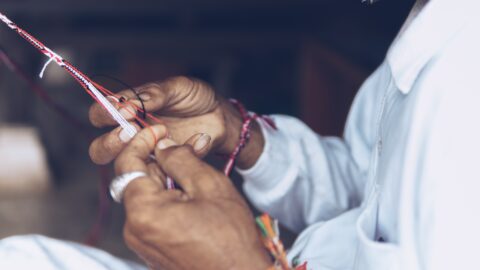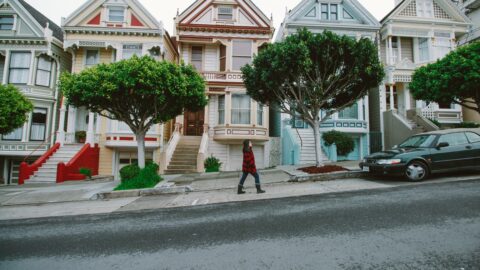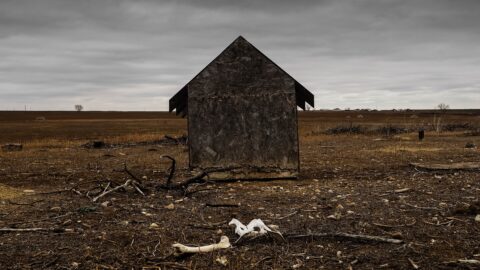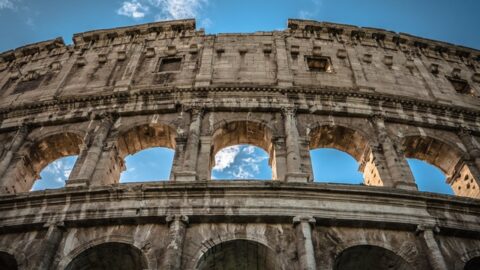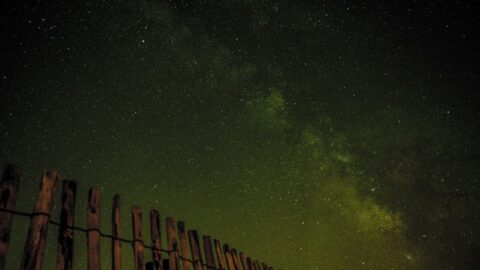“Saraswati Takes Back the Alphabet”: An Interview with Shilpa Kamat
I was driven by the forces that create and break language: sound, migration, immigration, alienation, speech, accent, imperialism, place, longing, myth, consciousness, archetype, universality, magic.” – Shilpa Kamat, “Saraswati Takes Back the Alphabet”
Poet, visual artist, and educator Shilpa Kamat contends with the violent legacies of imperialism, her lived experience, language, and threats of erasure in her chapbook, “Saraswati Takes Back the Alphabet,” finalist for the 2018 Anzaldúa Poetry Prize. In “eleven,” mid-way through the chapbook, Kamat writes, “the demons were never/ evil just regular/ people who prayed.”
The content of Kamat’s life—the experience of thinking across multiple languages, and being rooted in a particular lineage, Konkani, while having grown up elsewhere—is woven into the chapbook. She is concerned with nuance and layers, integrating her fascinations with magic and the sociopolitical without oversimplifying the past. Kamat is committed to exploring where magic still resides despite every violent attempt to erase it.
“French Braid”: An Interview with Rennie Ament
Part instruction manual for living, part mourning song and meditation on America, Rennie Ament’s aptly titled chapbook, “French Braid,” weaves stories of being both at home and not at home in the world. The 2018 Anzaldúa Poetry Prize finalist braids lived experiences with the absurd, painting strikingly vivid, arresting scenes that rouse readers’ emotions and intellect. As she writes, “you have to be the explosion you wish to see,” and her poetry is precisely that: an explosion that we all need to see.
Rennie Ament’s work has appeared in Colorado Review, Sixth Finch, Redivider, Yalobusha Review, minnesota review, The Journal, DIAGRAM, and elsewhere. She is the winner of the 2018 Yellowwood Prize in Poetry from Yalobusha Review and a nominee for both the Pushcart Prize and Best New Poets. She’s also received fellowships from the Millay Colony, the Saltonstall Foundation, the New York State Summer Writers Institute and the Vermont Studio Center. She lives in New York City.
Jamie Wagman: I would love to hear a bit about your writing life and your process. What’s influenced your writing? When did you first know you were a writer, and what has your journey as a writer been like? What delights and what scares you most as a writer?
Rennie Ament: Poem-wise, I don’t pay attention to semantics at first. I’ll give myself some kind of formal constraint (a sonnet, “e” the only vowel allowed, words can only come from a specific source text), but mostly I want to play in language and surprise myself. It’s fun to scribble gibberish until something sounds both strange and true.
Local Magic and Poetry in Noor Al-Samarrai’s “El Cerrito”
Noor Al-Samarrai’s debut poetry collection, “El Cerrito” (Inside the Castle, 2018) documents the wanderings and explorations of its narrator as she travels the suburbs of El Cerrito, California. Formally, the project is split into two major components: the poems themselves and the extensive footnotes which document the historical and personal references made throughout the book.
Beauty Eases Pain in Judy Jordan’s Poetry Collection “Hunger”
“What would happen if one woman told the truth about her life? The world would split open.” – Muriel Rukeyser
Poetry collection “Hunger” by Judy Jordan (Tinderbox Editions, 2018) is an honest, intimate account of a woman and her pain. The speaker in the poems faces homelessness after an accident that injured a spinal disk in the small of her back. When the hospital bills became too expensive and she fell behind on payments, the hospital seized the narrator’s bank account. Every dollar to her name is given to the hospital, leaving the woman alone, impoverished and homeless. She goes into the forest where she lives in an abandoned greenhouse, with hordes of plants and insects for Jordan to describe in detail. Our speaker is injured and unable to provide for herself, breeding a physical and spiritual hunger.
Jordan uses the protagonist’s unique situation as a playground for poetry and imagery, giving us thick, clamoring descriptions to guide us through this chaotic situation.
“Diffusely Yours” by Kate Garklavs Suggests We Are All Connected on an Atomic Level
In the chapbook Diffusely Yours by Kate Garklavs (Bottlecap Press, 2018) each poem is a letter to a person or institution. These poem-letters are playful, absurd and full of private meaning.
The speaker diffuses bits of herself and her very visceral memories to a friend, lover or regular haunt, but it also clear she has absorbed parts of these people and places into herself as well.
Erasure and Apocalypse in Claire Wahmanholm’s “Night Vision”
In Claire Wahmanholm’s poetry chapbook “Night Vision” (New Michigan Press, 2017), the world is transformed and brought to its most primal state after some catastrophic events that readers may never be quite sure of. The chapbook includes 30 poems—21 prose poems and nine erasure poems. (Erasure poetry is a form where an entire page of found text will be erased until only a few words remain. These leftover words form a poem.)
All nine erasure poems in “Night Vision” come from the wildly popular “Cosmos” by Carl Sagan, setting a reader expectation of wonder at the universe.
Loss an destruction are detailed instead, through Wahmanholm’s gripping yet elusive prose.
Beyond “Dualities” in Poetry by Jason Phoebe Rusch
“Dualities,” the debut poetry collection by Jason Phoebe Rusch (Short Flight/Long Drive Books, 2018), is a coming of age story told in mostly first person. The collection of poetry glimpses into someone’s life, one narrative at a time. Rusch captivates readers with vivid words describing times, places and feelings.
In “What Do You Love About Haiti?” readers get to know a little more about Rusch. He travels, including time in Haiti during an earthquake. The powerful images here suggest he witnessed the aftermath of the 7.0 magnitude earthquake in 2010, as Rusch states:
I’d never seen a dead body
before the earthquake. The earth
that day felt like something moving
underneath, in pursuit…
After the earthquake, I became accustomed
to the smell of death, no longer noticed it
clinging to my clothes, my skin. It became
the norm that houses should look like dioramas,
rooms exposed: staircases twisted and mangled,
kitchen tables tilting.
These words leave the reader uncomfortable yet compassionate. Indeed, uncomfortable yet compassionate is the theme throughout “Dualities.”
Deconstruction and Rebirth in the Poetry of Caseyrenée Lopez
Debut poetry collection “the new gods” by Caseyrenée Lopez (Bottlecap Press, 2018) uses rich language to conduct an examination of the body: how bodies are placed within pop culture, how they are valued or derided in society, and how they are the vessels that lead us through love.
Anemochore: An Interview with Meredith Stricker
Meredith Stricker’s Anzaldúa Poetry Prize winning chapbook “Anemochore” is truly beautiful and inspiring. From her unique and layered title “Anemochore,” to her intricate design and use of space on each page, Stricker offers as much insight and perspective from their placement of her words as from their meaning.
“Anemochore” keeps no borders between visual art, poetry and even music. Stricker’s work here demonstrates a melding of ideas that flow naturally from page to page, evoking all of a reader’s senses.
Meredith Stricker fuses her work with her own experiences, including performances with musicians, her own work as an architect in Big Sur, California and her deep perspective into the value of poetry and imagery. The second part of the chapbook, The Be/s of the Invisible, was a collaboration with several other musicians that link the life of bees to the freedom in poetry.
Her chapbook “Anemochore” will be published by Newfound in spring of 2018.
Steve Mulero: When did you begin writing poetry and what were some of your influences on your early journey into poetry and art?
Meredith Stricker: Because my mother was a war refugee for whom English was a second language and my father’s family from Russia spoke in an archaic form of German, I grew up
in a household where several languages mingled in ways that were basically incomprehensible to me, except as a kind of music or rhythm that was deeply familiar, but also untranslatable.
“Cryptopedia” – An Interview with Andrew Demcak
Andrew Demcak’s “Cryptopedia” is a collection that lives up to the mystery and intrigue promised by its title. “Cryptopedia” succeeds with that most fundamental and pleasing of poetic ideas: finding harmony between form and content. The 2017 Anzaldúa Poetry Prize finalist is a poet, a novelist, and, as he says, a “content creator in various forms.”
Demcak is a Renaissance man who works in unusual ways, cutting up blocks of text from a variety of sources and rearranging them, to create his poems. In “Cryptopedia” he mixes this method with the murky, monstrous and mysterious to create something unsettling yet genuinely moving and thought-provoking. Demcak’s success comes from his pitch-perfect subject choices and his ability to turn a seemingly random selection of lines and quotes into a twisting narrative, a short, emotive gut-punch. It takes talent to write poetry, but Demcak has proved he is not only a great talent, but a true craftsman.
Demcak’s poetry has appeared in a range of journals and we were lucky enough to have him share his craft, as well as some words of wisdom, with us at Newfound.
[Lukao] by Craig Santos Perez: The Birth and Life of an Island
Right from the get-go, Craig Santos Perez lets the reader know that the space they enter is a personal one. Poetry collection [Lukao] (Omnidawn, 2017) is laden with natural beauty, heartfelt stories and sincere love. It also reveals the everyday truth behind the island of Guam and, indeed, the world at large.
Before we even reach the poetry, the collection offers what Perez calls a “poemap,” a picture outlining Guam’s cable network. The small island is crisscrossed with black lines which, according to Perez, “carry almost all transpacific Internet traffic.” Guam is a hub, interconnecting the USA with other continents. It’s a striking image to begin a book of poetry with, not least because of its utilitarianism. Guam is a tool for the United States, the reader sees, introducing the expectation of seeing the life and love breathing between those cables. Or struggling between them.
Hidden Romanticism in the “Post Human” Poetry of Nate Pritts
It is impossible to deny that recent technological developments in biotechnology, cognitive science and “big data” infrastructure have made us, as a civilization and as artists, aware of all that is problematic in technology. We may call this movement toward introspection “post-humanism,” an exploration of technology’s advancements and controversies. This philosophy began as a niche within feminism from Firestone to Haraway, then existed in the cult realm of trans-humanism or as a science-fiction fixture.
“The Former Lives of Saints”: Collaboration, Poetry, and Community
“The Former Lives of Saints” is a collection of poetry from Damian Rucci and Ezhno Martin. Rucci is a New Jersey native and hosts the monthly poetry event in the Jersey Shore town of Keyport called Poetry in the Port. He met Martin in Missouri while on a reading tour; Martin still lives there today. Their collaboration on this collection soon followed. The release party for “The Former Lives of Saints” was hosted in Keyport on June 8, 2017.
Risqué Poetry is Not So Novel: Notes on the Gathasaptasati of Satvahana Hala
The Gathasaptasati is a volume of poetry, mostly written by women, and was supposedly collected and edited by the Satvahana king, Hala.
Ezra Dan Feldman’s Habitat of Stones
Ezra Dan Feldman’s poetry collection “Habitat of Stones” (Tebot Bach, 2016) is tied together by a certain “arrogant man.” This recurrent theme throughout the collection also bumps up against notions of the body: its finitude, its mortality and the struggles and regret of intimate relationships.
“The Graffiti of Pompeii” – An Interview with Laura Sobbott Ross
Laura Sobbott Ross has been writing poetry since she was a teenager. Her writing has appeared in The Florida Review, Meridian, and many others. She was a finalist for the 2016 Newfound Anzaldúa Poetry Prize, as well as a finalist for the Pushcart Prize and the Arts & Letters Poetry Prize in 2016.
Guilt and Redemption in “Disinheritance” by John Sibley Williams
The poetry collection “Disinheritance” by John Sibley Williams (Apprentice House, 2016) carries a sense of weight and burden of many kinds but primarily of the private kind, of private memories, histories, families, of the past, present and the future.
Nada Faris’s “Fountain of Youth”: A Collection of Fiery Poems
We do judge books by covers and blurbs even though we are taught not to do so early in childhood. The blurb of Nada Faris’s new collection of poetry “Fountain of Youth” (Vine Leaves Press, 2016) introduces her as a poet from Kuwait and a person associated with Iowa University’s International Writing Program. My only introduction to Kuwait has been through the electronic music of Fatima Al Qadiri (in many ways a true contemporary to Faris). I had no clue what was in store.
devorah major’s “and then we became” is a pilgrimage to the infinite
The reverence and lyricism of devorah major’s poetry collection “and then we became” (City Lights, November 2015) is a gift to all readers as we move into the darkest days of the year.
I picked up an early copy of this collection at City Lights Bookstore in San Francisco, so it was a special treat for me to be able to match my own experiences with these sights and sounds with the scenes from the poem “brown lady in white”
i have seen her
scurrying down mission street
gusting through tenderloin
pushing past crowds on market
Mothers, Daughters, and John Steinbeck
I am the kind of girl who calls her mother every day.




